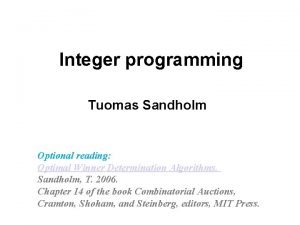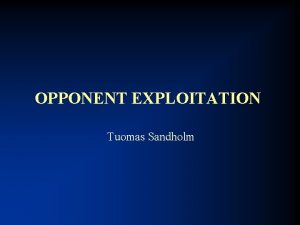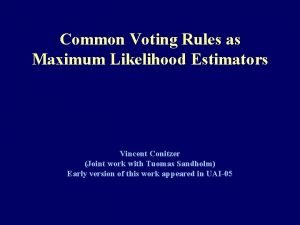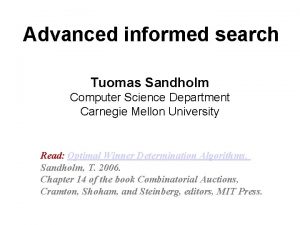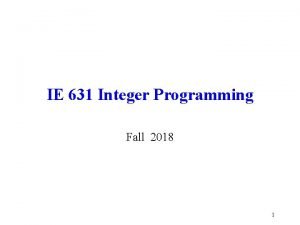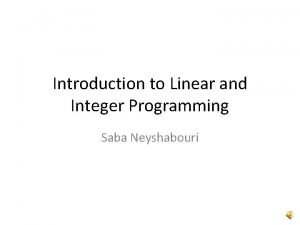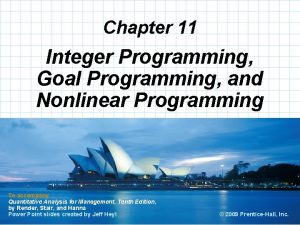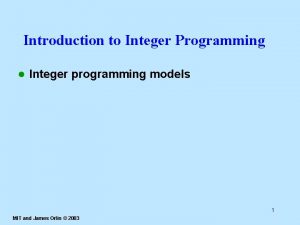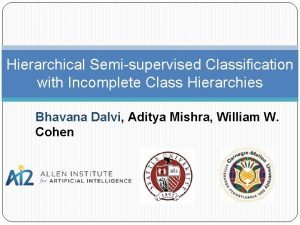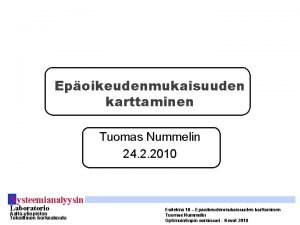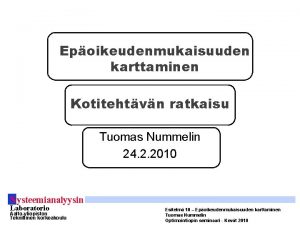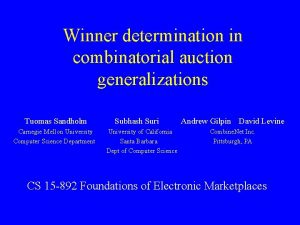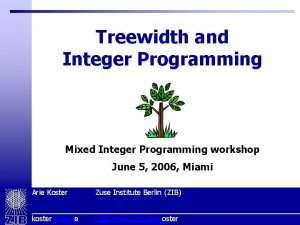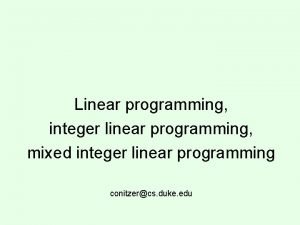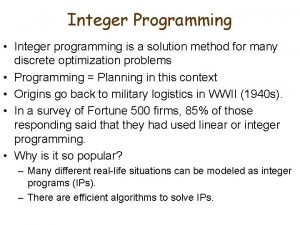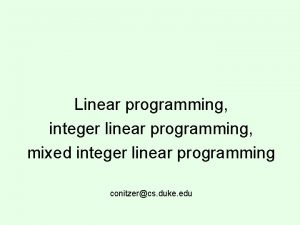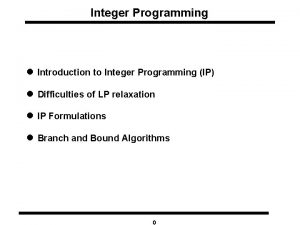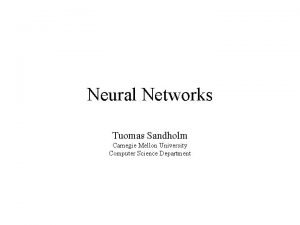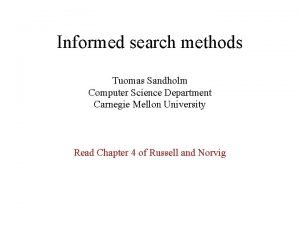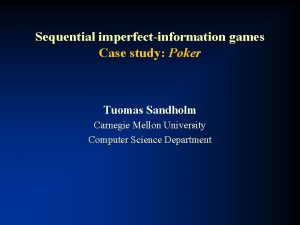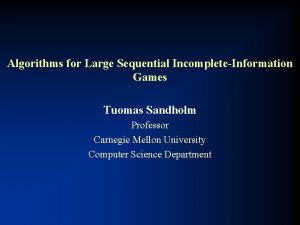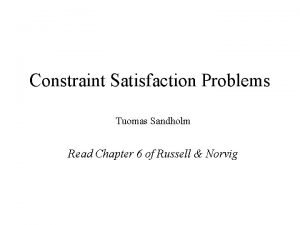Integer programming Tuomas Sandholm Optional reading Optimal Winner


















![Example 1: “Short” bids [Sandholm & Suri AAAI-00, AIJ-03] • Never branch on short Example 1: “Short” bids [Sandholm & Suri AAAI-00, AIJ-03] • Never branch on short](https://slidetodoc.com/presentation_image/9a189e5b74041598396055cfb07ea7b6/image-19.jpg)

![Example 3: [Sandholm & Suri AAAI-00, AIJ-03] Example 3: [Sandholm & Suri AAAI-00, AIJ-03]](https://slidetodoc.com/presentation_image/9a189e5b74041598396055cfb07ea7b6/image-21.jpg)
![Example 3. . . • Thrm. [Conitzer, Derryberry & Sandholm AAAI-04] An item tree Example 3. . . • Thrm. [Conitzer, Derryberry & Sandholm AAAI-04] An item tree](https://slidetodoc.com/presentation_image/9a189e5b74041598396055cfb07ea7b6/image-22.jpg)
![Example 4: Even more generality: Item graphs [Conitzer, Derryberry, Sandholm AAAI-04] • Item graph Example 4: Even more generality: Item graphs [Conitzer, Derryberry, Sandholm AAAI-04] • Item graph](https://slidetodoc.com/presentation_image/9a189e5b74041598396055cfb07ea7b6/image-23.jpg)



![Generalization: substitutability [Sandholm IJCAI-99, AIJ-02] • • What if agent 1 bids – $7 Generalization: substitutability [Sandholm IJCAI-99, AIJ-02] • • What if agent 1 bids – $7](https://slidetodoc.com/presentation_image/9a189e5b74041598396055cfb07ea7b6/image-27.jpg)

- Slides: 28

Integer programming Tuomas Sandholm Optional reading: Optimal Winner Determination Algorithms. Sandholm, T. 2006. Chapter 14 of the book Combinatorial Auctions, Cramton, Shoham, and Steinberg, editors, MIT Press.

Integer program (IP) max ctx subject to Ax ≤ b x ≥ 0, and integer Example: z*: = max z = 5 x 1 + 8 x 2 s. t. x 1 + x 2 ≤ 6 5 x 1 + 9 x 2 ≤ 45 x 1, x 2 ≥ 0, and integer

Why study integer programming in an AI course? • Integer programming and search are closely related. There is great benefit from knowing ideas from both so one can cross-fertilize across the two (in both directions) • Integer programming is the leading tool in a myriad of AI applications, e. g. : – – – Probabilistic inference Optimal clustering Combinatorial auction winner determination Kidney exchange Traveling salesperson problem Supervised learning

IPs typically solved using tree search • A branching decision can be thought of as adding a constraint to the integer program – In a binary integer program, branching is setting a variable to 0 or 1 – If the integer variable is not binary, then don’t have to necessarily branch to assign a specific value (e. g. , xi = 3), but, e. g. , xi ≥ 7 • The latter can be used to have similar numbers of values on both branches, and thus similar tree sizes under both branches. (Why is this desirable? )

Branch and bound •

Cutting planes (aka cuts) • Extra linear constraints can be added to the LP to reduce the LP polytope and thus give tighter bounds (less optimistic f-values) if the constraints are guaranteed to not exclude any integer solutions => smaller search tree • Application-specific vs. general-purpose cuts • Branch-and-cut algorithm = branch-and-bound algorithm that uses cuts – A global cut is valid throughout the search tree (in what follows, we’ll only consider these) – A local cut is guaranteed to be valid only in the subtree below the node at which it was generated (and thus needs to be removed from consideration when not in that subtree)

Example: Combinatorial auction winner determination problem

Example of a cut that is valid for winner determination: Odd hole inequality An edge in this constraint graph means that bids share items, so both bids cannot be accepted. E. g. , 5 -hole x 8 x 3 x 2 No chord x 1 x 6 x 1 + x 2 + x 3 + x 6 + x 8 ≤ 2

Separation using cuts LP optimum Valid cut that separates Valid cut that does not separate Invalid cut

How to find cuts that separate? • For some cut families (and/or some problems), there are polynomial-time algorithms for finding a separating cut • Or, use: – Generate a cut • Generation preferably biased towards cuts that are likely to separate – Test whether it separates

Gomory cut • Applicable to all problems where objective and constraints are linear • Valid • Cut is generated automatically using the LP optimum so that the cut separates • Very fast to generate (low-order polynomial time) • Powerful for many problems

How to generate Gomory cuts? z*: = max z = 5 x 1 + 8 x 2 s. t. x 1 + x 2 ≤ 6 5 x 1 + 9 x 2 ≤ 45 } [Example from http: //www. ms. unimelb. edu. au/~moshe@unimelb/620 -362/gomory /] z*: = max z = 5 x 1 + 8 x 2 Assume coefficients and right hand sides are integers. (Can convert into this form if they are originally rational. ) Introduce slack variables x 1, x 2 ≥ 0, and integer Optimal LP solution is x=(2. 25, 3. 75) and the final Simplex Tableau is: BV x 1 x 2 s 1 s 2 RHS x 1 1 0 2. 25 -0. 25 2. 25 x 2 0 1 -1. 25 0. 25 3. 75 z 0 0 1. 25 0. 75 41. 25 Second row in Simplex Tableau represents the constraint 0 x 1 + x 2 - 1. 25 s 1 + 0. 25 s 2 = 3. 75 This constraint generates the following Gomory cut: 0. 75 s 1 + 0. 25 s 2 ≥ 0. 75 General process for generating a Gomory cut from a row: 1. Express each of the coefficients of the constraint as the sum of an integer and a non-negative fraction 2. Drop all the integer terms and change the = to ≥ s. t. x 1 + x 2 + s 1 = 6 5 x 1 + 9 x 2 + s 2 = 45 x 1, x 2, s 1, s 2 ≥ 0, and integer

Why is this valid? Obvious Theorem. Let IL and IR be any two integers, f a positive non-integer fraction, and F the sum of nonnegative fractions such that IL + F = IR + f Then F ≥ f.

Question If one creates (Gomory) cuts at the root, are they global or local? If one creates (Gomory) cuts at some other node of the search tree, are they global or local? [A] global; global [B] global; local [C] local; global [D] local; local

Advanced topics • There is a more complex Gomory cut for problems that also have real variables in addition to integer variable • There also many other families of cuts, both general-purpose ones and problemspecific ones

Advanced topic: amazing! Gomory’s cutting plane algorithm • • Integer program (not one that also has real variables) can be solved with no search by an algorithm that generates a finite number of these cuts. How many? • A: Potentially exponentially many In each iteration: • Generate a cut (LP Tableau guides which cut is generated) • Include a new slack variable corresponding to that cut • Optimize the new LP (e. g. , using dual simplex algorithm) Rules against cycling in LP solving are needed to guarantee optimality in a finite number of steps • E. g. , http: //www. math. unl. edu/~shartke 2/teaching/2008 f 432/Handout_Gomory. pdf While this algorithm has been viewed as a mere curiosity, it has very recently shown promise on some practical problems (the choice of anti-cycling rule is key for speed in practice).

Some good variable-selection heuristics for integer programs • “Strong branching” (= 1 -step lookahead) – At a node, for each variable (from a set of promising candidate variable) in turn, pretend that you branch on that variable and solve the node’s childrens’ LPs • Sometimes child LPs are not solved to optimality (cap on # of dual pivots) to save time – Pick the variable to branch on that leads to tightest child LP bounds • Sometimes better and worse child are weighted differently • “Reliability branching” – Like strong branching, but once lookahead for a certain variable has been conducted at a large enough number of nodes, stop doing lookahead for that variable, and use average reduction in bound in past lookaheads for that variable as that variable’s goodness measure • The design of good variable-selection heuristics for integer programs is largely an open research question – Goodness of a variable-selection heuristic may also depend on the node-selection rule (e. g. , A* versus DFS)

Identifying & solving tractable cases at search nodes (so that no search is needed below such nodes) [Sandholm & Suri AAAI-00, AIJ-03; see also Sandholm et al. Management Science 2005]
![Example 1 Short bids Sandholm Suri AAAI00 AIJ03 Never branch on short Example 1: “Short” bids [Sandholm & Suri AAAI-00, AIJ-03] • Never branch on short](https://slidetodoc.com/presentation_image/9a189e5b74041598396055cfb07ea7b6/image-19.jpg)
Example 1: “Short” bids [Sandholm & Suri AAAI-00, AIJ-03] • Never branch on short bids with 1 or 2 items – At each search node, we solve short bids from bid graph separately • O(#short bids 3) time at the node using maximal weighted matching – [Edmonds 65; Rothkopf et al 98] • NP-complete even if only 3 items per bid allowed – Dynamically delete items included in only one bid • Can also do both short and long bids in polytime – So, the NP-hardness of the winner determination problem is caused by medium-sized bids

Example 2: Interval bids • • • At each search node, use a polynomial algorithm if remaining bid graph only contains interval bids – Ordered list of items: 1. . #items – Each bid is for some interval [q, r] of these items – [Rothkopf et al. 98] presented O(#items 2) DP algorithm – [Sandholm&Suri AAAI-00, AIJ-03] DP algorithm is O(#items + #bids) • Bucket sort bids in ascending order of r • opt(i) is the optimal solution using items 1. . i • opt(i) = max b in bids whose last item is i {pb + opt(qb-1), opt(i-1)} Identifying linear ordering – Can be identified in O(|E|+|V|) time [Korte & Mohring SIAM-89] Interval bids with wraparound can be identified in O(#bids 2) time [Spinrad SODA-93] and solved in O(#items + #bids)) time using our DP while DP of Rothkopf et al. is O(#items 3)
![Example 3 Sandholm Suri AAAI00 AIJ03 Example 3: [Sandholm & Suri AAAI-00, AIJ-03]](https://slidetodoc.com/presentation_image/9a189e5b74041598396055cfb07ea7b6/image-21.jpg)
Example 3: [Sandholm & Suri AAAI-00, AIJ-03]
![Example 3 Thrm Conitzer Derryberry Sandholm AAAI04 An item tree Example 3. . . • Thrm. [Conitzer, Derryberry & Sandholm AAAI-04] An item tree](https://slidetodoc.com/presentation_image/9a189e5b74041598396055cfb07ea7b6/image-22.jpg)
Example 3. . . • Thrm. [Conitzer, Derryberry & Sandholm AAAI-04] An item tree that matches the remaining bids (if one exists) can be constructed in time O(|Bids| |#items that any one bid contains|2 + |Items|2) • Algorithm: – – Make a graph with the items as vertices Each edge (i, j) gets weight #(bids with both i and j) Construct maximum spanning tree of this graph: O(|Items|2) time Thrm. The resulting tree will have the maximum possible weight #(occurrences of items in bids) - |Bids| iff it is a valid item tree • Complexity of constructing an item graph of treewidth 2 is unknown but it is NP-hard already for treewidth 3 [Gottlob & Greco EC-07] (but complexity of solving any such case given the item graph is “polynomial-time” - exponential only in the treewidth)
![Example 4 Even more generality Item graphs Conitzer Derryberry Sandholm AAAI04 Item graph Example 4: Even more generality: Item graphs [Conitzer, Derryberry, Sandholm AAAI-04] • Item graph](https://slidetodoc.com/presentation_image/9a189e5b74041598396055cfb07ea7b6/image-23.jpg)
Example 4: Even more generality: Item graphs [Conitzer, Derryberry, Sandholm AAAI-04] • Item graph = graph with the items as vertices where every bid is on a connected set of items • Example: Caltrain ticket Ticket to Alcatraz, San Francisco Rental car Ticket to Children’s Museum, San Jose Bus ticket • Does not make sense to bid on items in SF and SJ without transportation • Does not make sense to bid on two forms of transportation

Clearing with item graphs: our old friend Tree Decomposition! • Tree decomposition of a graph G = a tree T with – Subsets of G’s vertices as T’s vertices; for every G-vertex, set of T-vertices containing it must be a nonempty connected set in T – Every neighboring pair of vertices in G occurs in some single vertex of T • • Width of T = (max #G-vertices in single T-vertex)-1 Thrm. Given an item graph with tree decomposition T (width w), can clear optimally in time O(|T|2 (|Bids|+1)w+1) – Sketch: for every partial assignment of a T-vertex’s items to bids, compute maximum possible value below that vertex (using DP)

Application: combinatorial renting • There are multiple resources for rent • “item” = use of a resource for a particular time slot t 1 t 2 t 3 t 4 resource 1 resource 2 resource 3 … invalid bid • Assume every bid demands items in a connected interval of time periods • Green edges give valid item graph – width O(#resources) – can also allow small time gaps in bids by drawing edges that skip small numbers of periods

Application: conditional awarding of items • Can also sell a type of security: you will receive the resource iff state si of the world materializes – si are disjoint so that we never award resource twice s 1 s 2 s 3 s 4 resource 1 resource 2 … resource 3 • States potentially have a linear order – e. g. s 1 = “price of oil < $40, ” s 2 = “$40 < price of oil < $50, ” s 3 = “$50 < price of oil < $60, ” … • If each bid demands items in connected set of states, then technically same as renting setting
![Generalization substitutability Sandholm IJCAI99 AIJ02 What if agent 1 bids 7 Generalization: substitutability [Sandholm IJCAI-99, AIJ-02] • • What if agent 1 bids – $7](https://slidetodoc.com/presentation_image/9a189e5b74041598396055cfb07ea7b6/image-27.jpg)
Generalization: substitutability [Sandholm IJCAI-99, AIJ-02] • • What if agent 1 bids – $7 for {1, 2} – $4 for {1} – $5 for {2} ? Bids joined with XOR – Allows bidders to express general preferences – Groves-Clarke pricing mechanism can be applied to make truthful bidding a dominant strategy – Worst case: Need to bid on all 2#items-1 combinations OR-of-XORs bids maintain full expressiveness & are more concise – E. g. (B 2 XOR B 3) OR (B 1 XOR B 3 XOR B 4) OR. . . – Our algorithms apply (simply more edges in bid graph) – Can also be encoded using “dummy items” – Structure required for polytime special cases less frequent here See also more natural and compact bidding languages [Sandholm, T. 2013. Very-Large-Scale Generalized Combinatorial Multi-Attribute Auctions: Lessons from Conducting $60 Billion of Sourcing. Ch. 16 in The Handbook of Market Design]

Incremental generation of the search problem as needed • Branch-and-price – Column generation in the LP • Constraint generation
 Tuomas talvitie
Tuomas talvitie Tuomas sandholm
Tuomas sandholm Tuomas sandholm
Tuomas sandholm Tuomas sandholm
Tuomas sandholm Tuomas sandholm
Tuomas sandholm Tuomas sandholm
Tuomas sandholm Integer rules
Integer rules Perbedaan linear programming dan integer programming
Perbedaan linear programming dan integer programming Integer programming vs linear programming
Integer programming vs linear programming Definisi integer
Definisi integer Pre reading while reading and post reading activities
Pre reading while reading and post reading activities Linear vs integer programming
Linear vs integer programming Integer programming course
Integer programming course Saba neyshabouri
Saba neyshabouri Integer programming problem
Integer programming problem Fixed charge problem integer programming
Fixed charge problem integer programming Integer programming mit
Integer programming mit Integer programming example
Integer programming example Gomory cutting plane method
Gomory cutting plane method Mixed integer linear programming
Mixed integer linear programming Mixed integer linear programming
Mixed integer linear programming Application of integer programming
Application of integer programming Mixed integer linear programming
Mixed integer linear programming Mixed integer linear programming
Mixed integer linear programming Tuomas hulkkonen
Tuomas hulkkonen Gynekologit jyväskylä
Gynekologit jyväskylä Tuomas nummelin
Tuomas nummelin Tuomas nummelin
Tuomas nummelin Tuomas aura
Tuomas aura


